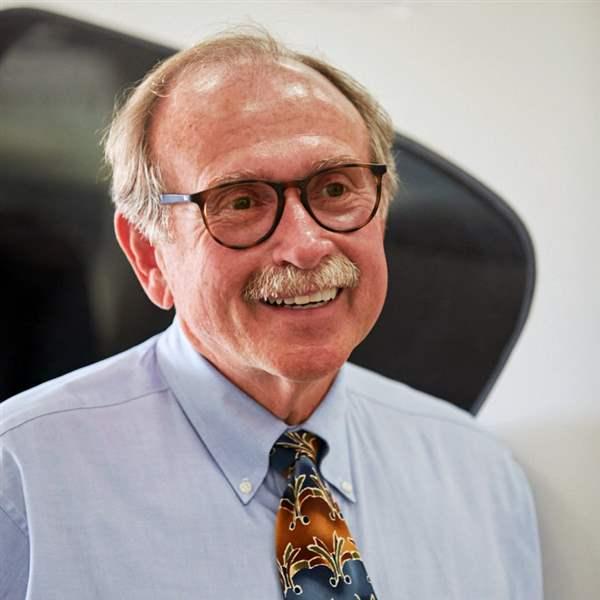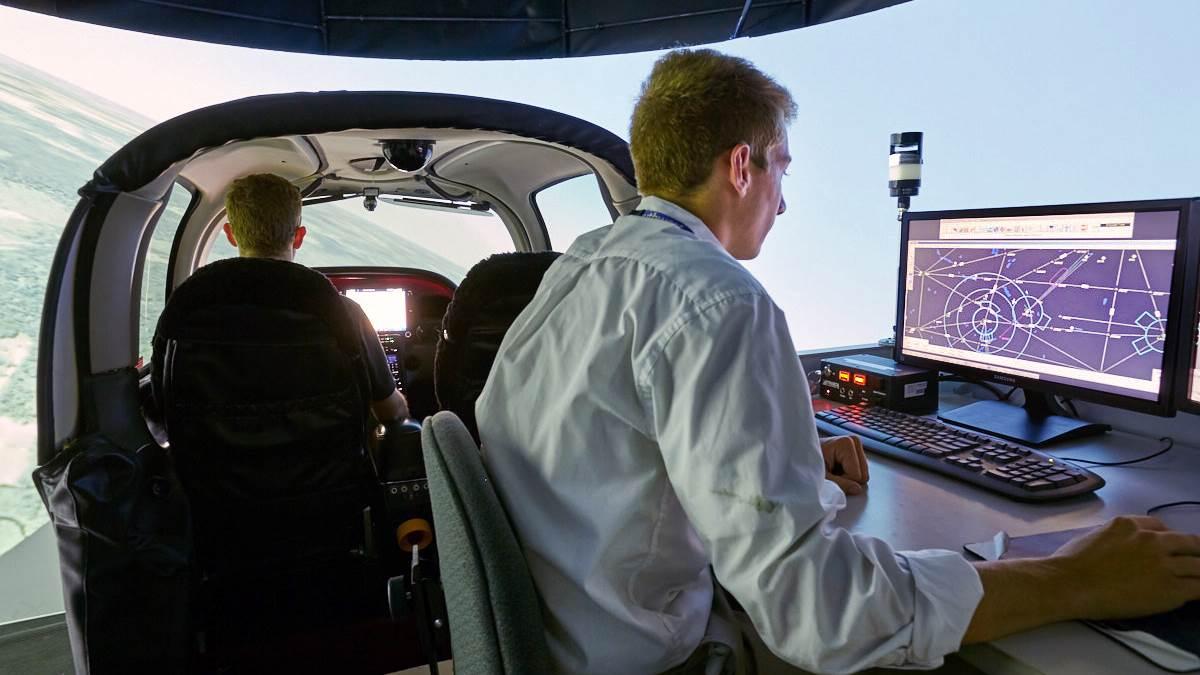The End Game
Aviation college focuses on getting a job

 Retired Capt. Dave Powell doesn’t see the world that way. He’s a practical man. Life wasn’t handing out tickets to ride to the young people he met in recession-depressed western Michigan. If you wanted—needed—a job, studying poetry and the great works was for other people. “College is meaningful, but in our profession, you’re learning the profession,” Powell said. “I understand the practicality; you’re coming here for one thing—to get a job.”
Retired Capt. Dave Powell doesn’t see the world that way. He’s a practical man. Life wasn’t handing out tickets to ride to the young people he met in recession-depressed western Michigan. If you wanted—needed—a job, studying poetry and the great works was for other people. “College is meaningful, but in our profession, you’re learning the profession,” Powell said. “I understand the practicality; you’re coming here for one thing—to get a job.”
“Here” is Western Michigan University’s College of Aviation, the flight training portion of which is located on the ramp at W.K. Kellogg Airport in Battle Creek, Michigan. Powell came here 10 years ago after the terrorist attacks of September 11, 2001, changed the airline industry. He was a chief pilot for United Airlines, had flown fighters in the military, and was type-rated in seven makes and models including the Boeing 777, but 9/11 changed his mind about the profession he had trained in and loved.
“I was 51 when I left the airlines and started at WMU,” he said. “I came here to prepare the next generation of pilots. I came here with a different perspective.”
That different perspective also sets him apart from most members of academia—Powell is a college dean who only holds a bachelor’s degree; no master’s, no PhD.
‘We train professional pilots’. The first thing Powell set out to do was to change the mindset of what the more than 75-year-old college considered training aircraft. “We needed to train today’s pilots in what’s going on today, not in the past,” Powell said. “New technology isn’t what came about 20 years ago. And we needed the industry to get involved in the training of the future.”
So Powell called Alan Klapmier, then president and CEO of Cirrus Aircraft Corp., the company that launched an all-composite, glass-cockpit general aviation aircraft—and, yes, the aircraft company that includes parachutes as standard equipment. “Cirrus are the best training platform,” said Powell. “They are faster, sturdier, stronger, and ultimately safer.”
College is meaningful, but in our profession, you’re learning the profession,” Powell said. “I understand the practicality; you’re coming here for one thing—to get a job. —Dean Dave PowellCirrus had tried to sell a similar concept to another college, so Klapmier understood Powell’s goals: “We wanted an exceptionally safe aircraft, we wanted for students to be able to transfer their skill set, and we wanted it to be affordable. Alan helped us achieve that,” Powell said. “All the technologies in the airlines that students will eventually discover, we have it.”

Former director of maintenance for WMU and now head of information technology and simulation, Bill Feenstra remembers when the Cirrus concept was introduced. “Steam gauge to glass, that was big,” he said. “We got some pushback—you can’t just jump right in, but we did.” He finished his instrument rating in a school’s SR20. “It’s not easier, but all the information you have makes it easier. Information, at your fingertips.”
WMU has 26 Cirrus SR20s and SR22s on its flight line. All are equipped with Avidyne’s Entegra R9 system. It was, as Powell says, a “leap of faith” for the WMU faculty to embrace the change. But WMU’s increasing enrollment and “lots of success stories,” says Powell, proves his point.
 Sophomore Suzie Targosz admits to being overwhelmed by the Cirrus at first but now says it’s a beautiful aircraft and fun to fly. “It sets a high standard and we will be well-prepared for the future,” she said. And junior Kyle Frederick said it was the lineup of Cirrus aircraft that he observed when he toured the campus that “really wowed me.” He too says initially the Cirrus was a lot to take in, but “my training has been a blast. There are so many things that help a student in the Cirrus—the Avidyne R9, autopilot, FMS—it really prepares you for a higher level.”
Sophomore Suzie Targosz admits to being overwhelmed by the Cirrus at first but now says it’s a beautiful aircraft and fun to fly. “It sets a high standard and we will be well-prepared for the future,” she said. And junior Kyle Frederick said it was the lineup of Cirrus aircraft that he observed when he toured the campus that “really wowed me.” He too says initially the Cirrus was a lot to take in, but “my training has been a blast. There are so many things that help a student in the Cirrus—the Avidyne R9, autopilot, FMS—it really prepares you for a higher level.”
Changing the future. Powell says he has two goals for the WMU program: be the best, not the biggest, and to bring diversity into the industry. “Most aviation looks like me: a white male. We want to change that,” he said.
There are approximately 875 students at WMU’s College of Aviation, about 25 percent from out of state. Powell says the cost of the program is “right in the middle” of average aviation program costs. “It’s going to take you 60 hours—not 40 like most schools say—so it looks more expensive, but we are honest and upfront. This is how long it’s realistically going to take.”
Powell emphasizes that the program trains “professional pilots.” Nearly 95 percent of WMU’s graduates go straight to regional carriers, about 5 percent enter the military or business aviation. That success rate has its downside—27 instructors from WMU were hired this summer by regional carriers, certainly changing the landscape. According to designated aviation examiner and CFI Jason Blair, who works and trains in the area, that’s resulted in an 8- to 9-percent decrease in his pass rate in his FSDO district. “Because of instructor turnover, I am seeing more errors caused by instructors with less experience in training as many students,” he said.
By their junior year, some students are working for the school as instructors. They get to build enough time while in college to be hirable as soon as they graduate. Great for the student, great for the school, but as soon as they graduate they are hired away now that there’s a hiring boom.
 Blair says of WMU, "As in any program, there are strengths and weaknesses. They take these kids and make them hirable. That’s great. They push people and they build them. They train great airline pilots. Their focus is less on general aviation pilots here, but that's not where their students go to work when they graduate,” he said.
Blair says of WMU, "As in any program, there are strengths and weaknesses. They take these kids and make them hirable. That’s great. They push people and they build them. They train great airline pilots. Their focus is less on general aviation pilots here, but that's not where their students go to work when they graduate,” he said.
Powell concedes that WMU is using advanced technology to train students, much like military or business jet training. “We copy what’s in the real world,” he said. Like simulator training. “We are building the pilot’s skill set in the simulator.” When Cirrus’ Klapmier visited WMU he, like many others, deployed the parachute system outside its envelope, “crashing” the simulated flight.
Sophomore Targosz especially likes the simulator training, calling it a “great tool.” She sees the rate of instructor turnover as a positive too, saying that learning from a fellow student is helpful. “Instructors are getting hired—that’s great. Jobs are awesome right now.” And Frederick says he’s working on his instrument rating now and plans to instruct in his senior year. “I just want to get paid to fly,” he said.
Powell says he’s proud of the “return on investment” a student will make at WMU. “You’re learning in a modern aircraft; you’re learning how to talk to the tower. We’re making you safe, preparing you to go into the industry. I don’t think there’s a better program in the world.”



